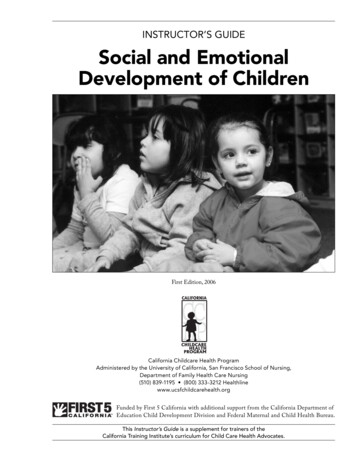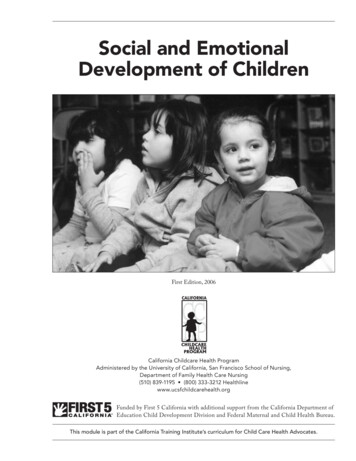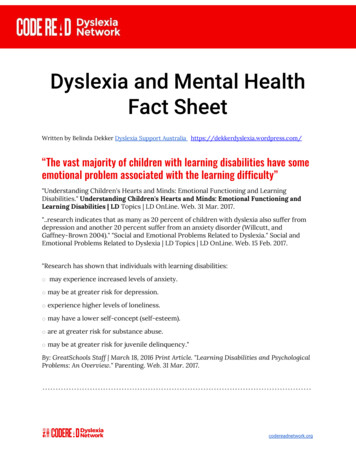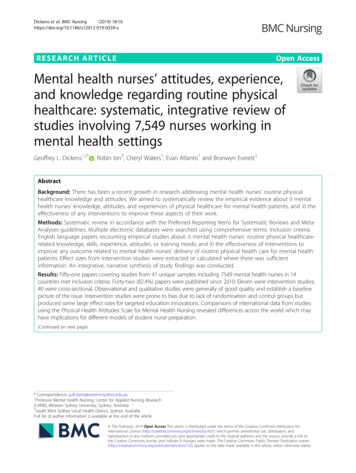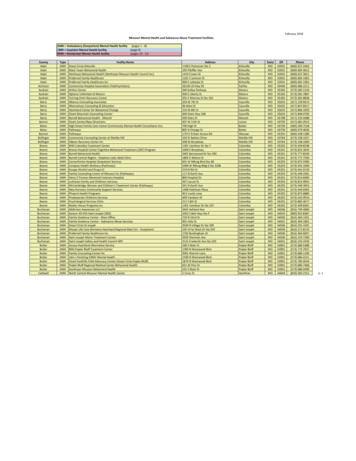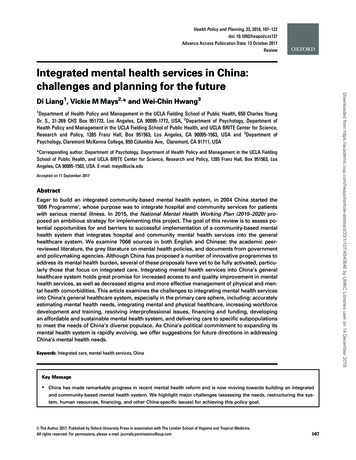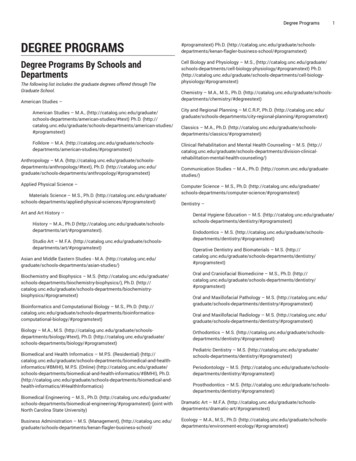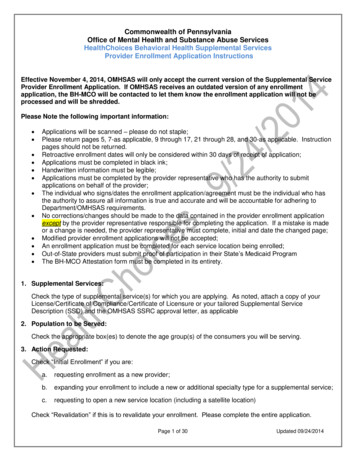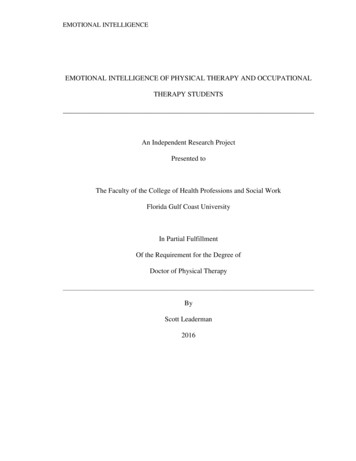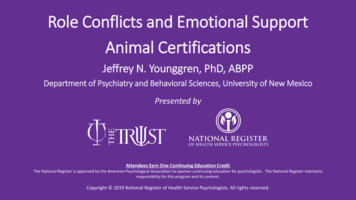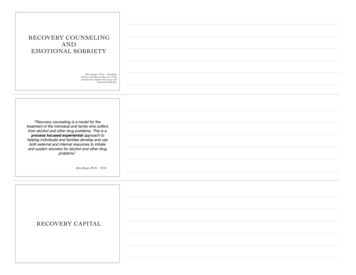
Transcription
6th GradeEmotional, Mental,and Social HealthUnit PlanDiana Crew
Page 2Table of ContentsUnit Description .p. 3Unit Rationale pp. 4-5Unit Plan Goals .p. 6Unit Plan Objectives .p. 7National Health Education Standard Performance Indicators .p. 8Unit Block Plan p. 9Unit Special Considerations (i.e. contextual factors) pp. 10-12Lesson Plans .pp. 13- 38Unit Assessment Strategies pp. 39-51Unit Resources and References .p. 52
Page 3Unit DescriptionGrade: 6thContent Area: Emotional, Mental, and Social HealthSkills: Identifying relationships, demonstrating personal responsibility, communicating clearly,demonstrating and identifying body language, and choosing and identifying the right behavior,Identifying the key characteristics of a good friend, deciphering and identifying the differencesbetween positive and negative peer pressure, identifying, understanding, and demonstratinghow to say know through scenarios, identifying and understanding conflict, identifying andunderstanding conflict with peers, identifying and understanding bullying, identifying anddemonstrating the decision making skills through real life scenarios, identifying an I-message,identifying the parts of an I-message, creating an I-message, using an I-message in a scenario,identifying and understanding what stress and stressors are, identifying and understandingdistress and eustress, demonstrating and identifying how to respond to stress in healthy ways,and identifying the effects that stress has on the bodyNumber of Lessons: 6Length of Class Periods: 45 minutes
Page 4Unit RationaleIn the United States, approximately 6 to 9 million children and adolescents have seriousemotional disturbances.1 Research shows that one of five children and adolescents aged 9to 17 years experience symptoms of mental health problems that cause some level ofimpairment in a given year.2Expenditures for children’s mental health services were nearly 11.75 billion in 1998—athreefold increase from 1986.3,4 Left untreated, mental health disorders in children andadolescents lead to higher rates of suicide, violence, school dropout, family dysfunction,juvenile incarcerations, alcohol and other drug use, and unintentional injuries. Schools canplay a vital role in creating safe, nurturing school environments and providing care tostudents with emotional or behavioral problems. According to the School Health Policy andPrograms Study of 2000, three-fourths of schools have a part-time or full-time guidancecounselor, two-thirds have a part-time or full-time psychologist, and slightly more than 40percent have a part-time or full-time social worker.5Student Assistance ProgramsA Student Assistance Program (SAP) providesservices designed to assist students experiencingpersonal or social problems that can impact schoolperformance, physical health, or overall well-being.34.0% of states and 51.2% of districtsrequire that SAPs be offered to all students.62.0% of elementary, 63.1% of middle/junior high, and 64.6%Health Services16.0% of states and 48.6% of districtsrequire that districts or schools provide one-on-oneor small-group discussions on suicide preventionto students when needed (not includingclassroom instruction).36.7% of districts have arrangements withorganizations or professionals not located onschool property to provide one-on-one or small groupdiscussions on suicide prevention tostudents when needed.Standard 2:Students will analyze the influence of family, peers, culture, media,technology, and other factors on health behaviors.
Page 5Standard 4:Students will demonstrate the ability to use interpersonalcommunication skills to enhance health and avoid or reduce healthrisks.Standard 5:Students will demonstrate the ability to use decision-making skills toenhance health.Standard 7:Students will demonstrate the ability to practice health-enhancingbehaviors and avoid or reduce health risks.
Page 6Unit GoalsGoals to gain through this communication unit:Express feelings in a healthy way.Engage in activities that are mentally and emotionally healthy.Prevent and manage conflict and stress in healthy ways.Use self-control and impulse-control strategies to promote health.Seek help for troublesome feelings.Be empathetic toward others.Carry out personal responsibilities.Establish and maintain healthy relationships.
Page 7Unit ObjectivesSWBAT identify what a relationship and personal responsibility are.SWBAT identify the differences between aggressive, assertive, and passive behaviors are.SWBAT demonstrate and analyze different types of body language during the body languageactivity.SWBAT demonstrate skills for refusing various offers.SWBAT identify the four qualities that make a good friend.SWBAT identify what a conflict is.SWBAT identify what bullying is.SWBAT demonstrate the ability to express their feelings by writing a complete I-message.SWBAT identify the many parts of an I-message.SWBAT identify what an emotion and a hormone are.SWBAT identify what mental health and emotional health are.SWBAT demonstrate a healthy way to manage their anger.SWBAT define Stress, stressors, distress and eustress.SWBAT recognize at least 3 different effects stress has on our bodies.SWBAT identify different stressors and label them either distress or eustress.SWBAT identify healthy and unhealthy options to deal with stress.
Page 8National Health Education Standards Performance IndicatorsHEALTH EDUCATION STANDARD 2 – Students will Analyze the influence of family, peers, culture,media, technology and other factors on health behaviors.HEALTH EDUCATION STANDARD 4 – Students will Demonstrate the ability to use interpersonalcommunication skills to enhance health and avoid or reduce health risks.HEALTH EDUCATION STANDARD 5 – Students will Demonstrate the ability to use decision-makingskills to enhance health.Benchmarks Linked to Objectives6.1.3 Describe the interrelationships of mental, emotional, social, and physical health duringadolescence.6.5.3 Demonstrate healthy ways to express needs, wants, and feelings including I messages andassertive communication strategies.6.8.2 Demonstrate refusal and negation skills to avoid or reduce health risks6.1.3. Demonstrate the interrelationships of mental, emotional, social, and physical healthduring adolescence.6.1.2 Summarize the interrelationships of emotional, social, and physical health in adolescence.6.5.2 Recognize when health-related situations require a thoughtful decision-making process.6.4.1 Investigate effective communication skills to enhance health.6.5.4Identify healthy and unhealthy options to health-related issues or problems.
Page 9Unit Block PlanDay 1: Behaviors and RelationshipsSkills: Identifying relationships, demonstrating personal responsibility, communicatingclearly, demonstrating and identifying body language, and choosing and identifying the rightbehaviorDay2: Friendship and Refusal SkillsSkills: Identifying the key characteristics of a good friend, decyfering and identifying thedifferences between positive and negative peer pressure, identifying, understanding, anddemonstrating how to say know through scenariosDay 3: Coping with ConflictSkills: Identifying and understanding conflict, identifying and understanding conflict withpeers, identifying and understanding bullying, identifying and demonstrating the decisionmaking skills through real life scenariosDay 4: I-messagesSkills: Identifying an I-message, identifying the parts of an I-message, creating an Imessage, using an I-message in a scenarioDay5: Dealing with EmotionsSkills: Identifying and understanding emotions: love, hate, anger, sadness, andhappiness, identifying and demonstrating how to deal with anger in a healthy way, andunderstanding why anger is good, identifying and understanding how emotions affect the bodyDay 6: Managing StressSkills: Identifying and understanding what stress and stressors are, identifying andunderstanding distress and eustress, demonstrating and identifying how to respond to stress inhealthy ways, and identifying the effects that stress has on the body
P a g e 10Unit Special ConsiderationsContextual Factors:Statistics for Valparaiso Community Schools:Schools, Teachers and StudentsAgency Schools(FTE) Classroom TeacherAveragesEnrollment Averagesfailing in school, abusing drugs, defiance, lowself-esteem, lack of motivation or poor familyrelationships? Are you looking for a BoardingSchool, Residential Treatment Program,Boot camp, Military School, wildernesscamp, or a Therapeutic Boarding School?Turning Winds Academic Institute is anindustry leading therapeutic private boardingschool for troubled teens.Enrollment Averages by Grade LevelKindergarten 1st Grade 2nd Grade 3rd Grade 4th Grade 5th Grade 6th Grade 7th GradeDistrict Avg410.0440.0447.0400.0420.0426.0489.0449.0
P a g e 11State Avg222.8249.4241.4238.5245.7248.1254.98th Grade 9th Grade 10th Grade 11th Grade 12th GradeDistrict Avg450.0532.0550.0487.0510.0State Avg247.2257.1228.6212.7199.4High School Graduation InformationDiploma Recipient AveragesDistrictStateAvgAmerican IndianAlaskan Native1.01.0 / 0.00.50.0 / 0.0AsianPacific Islander13.09.0 / 4.02.20.0 / 0.07.04.0 / 3.04.80.0 / 0.05.02.0 / 3.015.80.0 / 0.0468.0256.0 /212.0169.00.0 / 0.0494.0192.3TotalMale / FemaleHispanicAfricanAmericanCaucasianTotalOther High School Completer AveragesTotalMale / FemaleDistrict State AvgAmerican IndianAlaskan Native0.00.00.0 / 0.0 0.0 / 0.0AsianPacific Islander0.00.10.0 / 0.0 0.0 / 0.0HispanicAfrican AmericanCaucasianTotal0.00.30.0 / 0.0 0.0 / 0.00.01.00.0 / 0.0 0.0 / 0.02.03.72.0 / 0.0 0.0 / 0.02.05.2254.2
P a g e 12The above information and charts describes the contextual factors concerningschool information for Valparaiso Community School system.Mental, emotional, and social health concerns everyone from all different ages,races, genders, and economic statuses. When teaching this specific subject it is important tonot only remember to teach the major content areas of the unit but put large amounts ofstress on the skills part of the unit in order for students to understand the importance ofbecoming a good decision maker and communicator with their emotions and ideas. Whenworking with the middle school aged students, which is the age group that this unit planfocuses on, the most effective way to teach this unit’s skills would be to make sure that theinformation is up to date and relevant with real life examples so that the students are moreapt to participate and relate to the material. Students at this age learn more by doing thenby just listening alone. This age range is also crucial in teaching how to be fluent at thisunit’s skills because as students are enter middle school they are putting pressures onthemselves to fit in and find their place socially. In order for these students to mature andgrow into effective communicators and decision makers we need to start these unit’s skillsearly and stress their importance through real life examples.
P a g e 13Unit Lesson PlansLesson Plan 1Name: Diana CrewGrade Level: 6thUnit / Content Area: Interpersonal CommunicationLesson Title: Behaviors and RelationshipsObjectives:Objective 1and 2: SWBAT identify what a relationship and personal responsibility are.SWBAT identify the differences between aggressive, assertive, and passive behaviorsare.Health Standard Addressed: 6.1.3 Describe the interrelationships of mental, emotional, social,and physical health during adolescence.Objective 3: SWBAT demonstrate and analyze different types of body language during the bodylanguage activity.Health Standard Addressed: 6.5.3 Demonstrate healthy ways to express needs, wants, andfeelings including I messages and assertive communication strategies.Lesson OverviewContent OutlineI. Keeping you healthya. relationshipII. Teamworka. personal responsibilityIII. Communicating Clearlya. communicatorMethods /StrategyEstimatedTime NeededNecessary MaterialsLecture/Notesworksheet5 minNotes WorksheetLecture/Notesworksheet5 minNotes WorksheetLecture/Notesworksheet5 minNotes Worksheet
P a g e 14b. listenerIV. Using Body Languagea. body languageV. Choosing Behaviora. assertiveb. aggressivec. passiveVI. QuizLecture/Groupwork10-15 minLecture/Groupwork10-15 minAssessment5 ariocardsQuizTeaching StepsIntroductionOverview & Rationale for Today’s LessonIn today’s lesson you will investigate why relationships are important and what it means todemonstrate personal responsibility. You will explore forms of communication, forms of behavior, andthe benefits of using assertive behavior. It is important for everyone to have healthy relationships withfamily members, friends, teacher, etc .Necessary Teaching Steps1. Keeping You HealthyAsk: What is a relationship?Tell: A relationship is an emotional or social connection between two or more people. You haverelationships with your family, your friends, and your neighbors. All of these connections affectyou. Many of these relationships are different, but similar skills are used to keep all relationshipshealthy.Tell: When people in relationships are good to each other, they can help keep each other safeand healthy. People in healthy relationships look out for one another and help each other makegood choices. They do not put each other in dangerous situations. ((ex.) peer pressure to makean unhealthy decision) You can have healthy relationships with your family and friends.Ask: What are some ways to keep a relationship healthy?Tell: Keeping your relationship healthy takes work, skill, and responsibility.Content Bite: Listen carefully, cooperate, and let people know what youneed.2. TeamworkTell: For relationships to be healthy, everybody in the
between positive and negative peer pressure, identifying, understanding, and demonstrating how to say know through scenarios, identifying and understanding conflict, identifying and understanding conflict with peers, identifying and understanding bullying, identifying and demonstrating the decision making skills through real life scenarios, identifying an I-message, identifying the parts of an .
